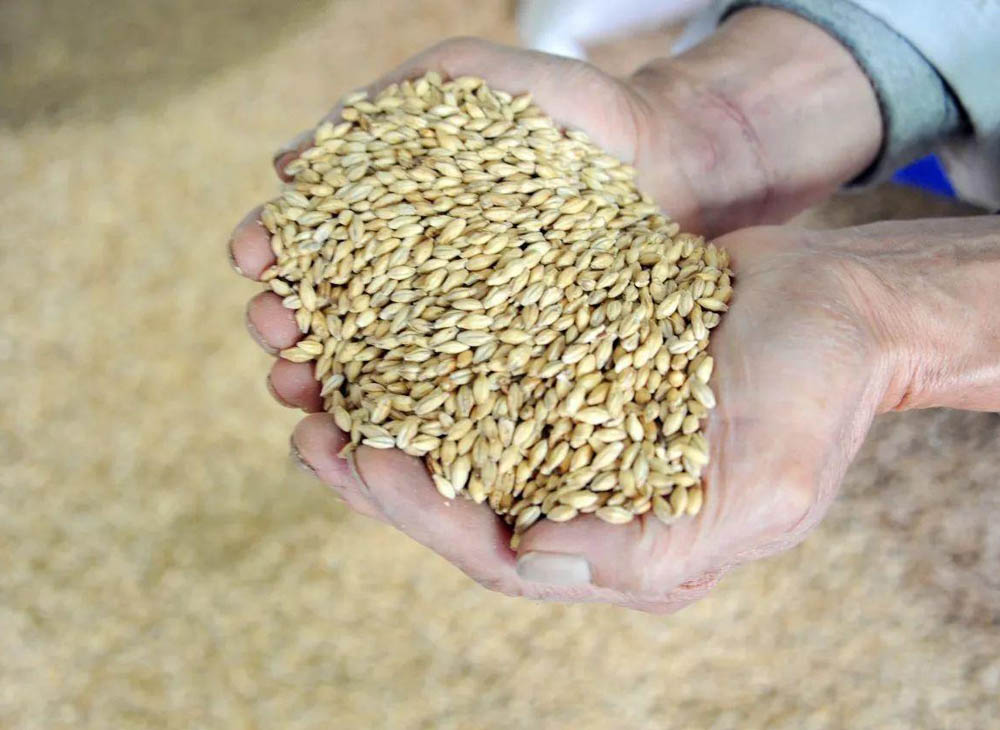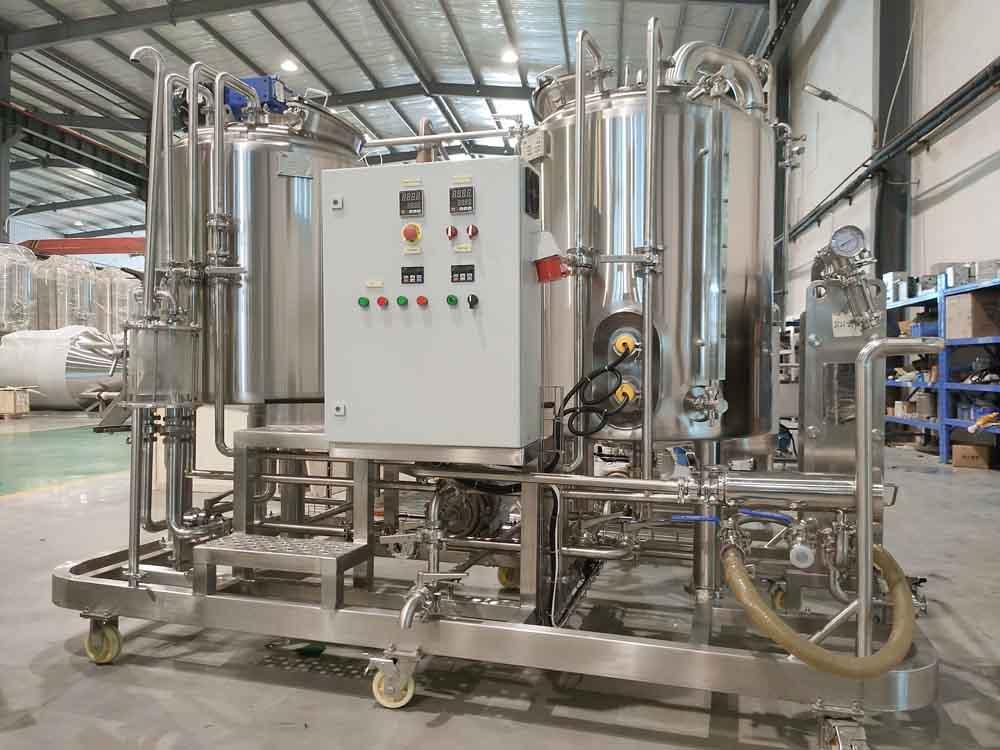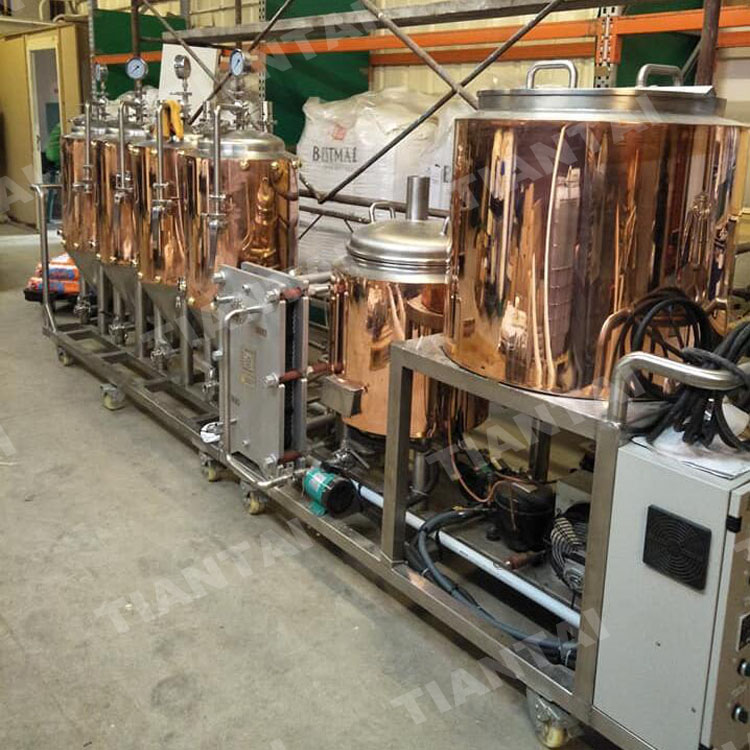Just how to pick the beer developing malt for a microbrewery?
- Jun 02, 2021
- 182
- tiantai
Malt, jumps, yeast, water are the standard elements to make beer. beer developing supply and also beer developing products are extremely crucial for a brewery. When you currently have the beer developing tools, after that you will certainly require to take into consideration exactly how to select the fundamental malt for beer developing. There have actually been substantial research studies right into each of these active ingredients as well as their effect on the last beer item, however commonly it is the big taste factors such as jumps, yeast, and also specialized malts that obtain one of the most interest. While the impact of base malts in the last beer item could be refined in contrast, it still will certainly have an impact on your beer and also understanding just how they influence the end product can assist you to far better forecast exactly how your last beer will certainly end up.
Base malts are specifically as they appear, the structure the beer is improved. They are the significant factor of the carbs (from starch), healthy proteins, and also enzymes in the beer. They are the workhorse of a malt expense as well as often are simply dealt with therefore, yet even if they are utilized mostly as a carb and also enzyme resource, that does not imply they are all compatible. Base malts have their refined distinctions too, as well as commonly there is a great reason a particular base malt was utilized in a provided dish. Recognizing the distinctions in the malts can assist you pick the appropriate base malt for your mixture.

6-row vs. 2-row malt
The very first facet to take into consideration in picking a base malt is whether it is a 2-row or a 6-row malt. Beyond the United States, 2-row is generally the criterion for all base malts, as well as you would certainly be difficult pushed to locate a 6-row malt for developing. Also in the United States, essentially, base malts will certainly usually be 2-row for a variety of factors. 2-row expands less grains on the head of the barley (2 per head as opposed to 6 per head). This permits the grains to expand plumper, and also will normally cause a bigger as well as extra constant grain dimension. 6-row on the various other hand will normally expand various dimensions of grains, partially due to the fact that the barley head is much more jampacked, however likewise since the grains expand in sets straight throughout from each various other on the head of the barley, as well as many times 2 of the grains on the head enlarge than the remainder. This brings about an irregular grain dimension with a few of the grains being bigger than the remainder. It is defined as having a mellower/maltier taste whereas 6-row is defined as having a grainier taste due to the fact that of the bigger grain dimension in 2-row malt. 2-row additionally has a greater starch web content as well as can create a greater remove, which is among the factors it is typically the barley of option for the majority of maltsters.
The rough taste of 6-row is partially as a result of the greater husk-to-malt proportion of the grain. The husks have a bulk of the tannins, polyphenols, as well as healthy proteins in the malt, so with a greater husk proportion, you will certainly remove even more of these high qualities in the created beer. One benefit of the greater husk proportion of 6-row malt remains in developing the filter bed throughout the lautering procedure. Having even more husks aids to develop a much better filter bed, so 6-row malt is usually much easier to lauter. When making use of accessory starch resources or a big proportion of very under-modified malt due to its boosted chemical task, 6-row malt additionally has greater chemical task as well as it is a great selection. That is just one of the reasons it is usually the option of huge manufacturing breweries. Big breweries will certainly make use of less expensive complements such as corn as well as rice, and also they require the enhanced chemical task to completely transform the accessories. An additional factor they will certainly pick 6-row malt is that it might set you back much less than 2-row malt depending upon where the brewery lies. The price financial savings originates from the truth that even more grain is created per barley stalk than 2-row, so you can generate even more malt per acre of grown barley, which reduces the price per extra pound of the completed item.
As discussed previously, generally you will just be utilizing 2-row malts in developing, yet 6-row does fit in beer manufacturing so it is excellent to be knowledgeable about its features.
One last note, malted barley is not constantly mosting likely to be the only resource of starch in a mash. Some designs will certainly typically ask for various other grains such as rye, oats, sorghum, and also wheat. These will certainly require the chemical task from the malt to transform the starches, or enzymes will certainly require to be included. If you are trying to find a high proportion of accessory grains, as well as you are not including any kind of added enzymes, take into consideration making use of 6-row malt for its greater diastatic power.
Distinctions in Base Malts
One more facet to take into consideration is the beginning of the base malt. Beyond the United States, base malts will certainly nearly solely originated from 2-row barley, as well as can have somewhat various taste attributes. There are a variety of factors that the taste can vary in base malts of the exact same design, consisting of where the barley is expanded (terroir), what barley range the maltster utilizes, the malting and also kilning procedure the maltster utilizes, what attributes the maltster is targeting, what dampness degree the maltster is targeting, and also a lot more options that the maltster will certainly make. Without entering into way too much information concerning malt manufacturing, the maltster will certainly establish the very best method to create a malt that drops within spec, and also is as constant as feasible with their previous malt sets. The maltster will certainly function carefully with the farmers, as well as typically will evaluate the barley and also obtain prior to dedicating to utilizing it for malting. They will certainly be seeking a variety of specifications consisting of, yet absolutely not restricted to, inactivity of the malt, healthy protein material, wetness web content, and also grain dimension. The maltster undergoes a great deal of effort to create a high-grade, constant base malt, as well as will certainly often make modifications on the fly to make sure that the malt is within defined criteria.
A great beginning factor in selecting which base malt to choose for your beer would certainly be considering the information the maltster offers. They will certainly usually offer a precise summary of the malt itself, as well as what qualities you can anticipate when utilizing their malt. In addition to taste descriptors, a maltster will certainly offer a few other specs concerning the malt. The specs might differ somewhat relying on what techniques were utilized, as an example EBC, asbc or ibd, as well as the number of examinations the laboratory made a decision to do, however usually you can locate details on the target variety or minimum/maximum of particular top qualities of the malt such as shade, dampness, healthy protein overalls, anticipated essence, and also use prices. There might be basically info, once again relying on what the laboratory is evaluating for, yet these qualities are usually examined with many base malts as well as can supply some important details. As a whole, reduced wetness malt will certainly stand up far better for storage space. Greater healthy protein can aid with much better head retention in the beer, as well as can provide better nourishment for the yeast throughout fermentation. This info can offer you a concept of just how the malt will certainly affect the last beer beyond its taste and also fragrance payments.
There are some basic standards you will certainly discover in malt from numerous malt expanding areas. North American malts can in some cases have an earthier as well as grassier particular, but also for one of the most component are thought about rather neutral. British malts are typically called being much more biscuity, bready, as well as malty. Maris Otter, a barley range usually made use of in British malts, is an ideal instance of the wonderful, biscuity tastes that you will certainly enter British malts. German malts can have a light malty and also in some cases a little medical phenolic quality.
If you are seeking to reproduce a details design, it can be a great concept to obtain and also attempt base malt from that area the design came from, as that is more than likely what the makers generating that design are utilizing. It is among the very best means to attempt to be real to design, although imported malts will normally come with a greater cost than residential malts to ensure that is something to think about. You can in some cases see rate financial savings getting malt wholesale by the bag, however when devoting to a complete bag of base malt you will certainly wish to make certain you discover something that you like as well as transforms well.
One of the ideal means to recognize them is to obtain your hands on the various selections and also offer them a preference if you are brand-new to the various base malts. Attempt to obtain a couple of examples of the exact same design (I would certainly suggest light malt or light ale malt) from a couple of various maltsters if feasible. It can aid you to much better comprehend local distinctions, as well as provide you a much better suggestion of what base malt you favor. Specific designs will certainly require various base malts and also utilizing the ideal base malt will certainly offer you the very best opportunity of making an outstanding beer. Like specialized malts, base malts additionally are available in a variety of ranges. These consist of: Pale malt, Pilsner malt, light ale malt, Vienna malt, as well as Munich malt.

Pale Malt
Pale Malt is one of the most typical of the base malts made use of in beer. It is frequently called merely called "2-row" malt. This can be a little complicated to brand-new makers as essentially all the malt they will certainly be utilizing is a kind of 2-row malt. Feel in one's bones that if a dish requires 2-row malt by name, they are describing fade malt. An additional name for the exact same sort of malt could be the barley selection itself such as Maris Otter.
Pale malt is light in shade and also typically will be around 2-2.5 levels Lovibond. It can be utilized to make generally any kind of beer design as well as is very customized so you will certainly not have any kind of difficulty obtaining essence from it. Begin with light malt if you are not certain what base malt you need to be making use of. It functions well in mostly all circumstances. This is most definitely an essential if you are looking to purchase malt in mass and also shop it on your own.
Pilsner Malt
Pilsner malt is generally lighter in shade than light malt, falling under the 1.5-2 levels Lovibond array. It is utilized for, as you possibly presumed, making Pilsner beers - commonly standard German as well as Czech Pilsners. It has a lighter as well as crisper taste than light malt and also the taste is extremely refined so it is best to utilize this malt with various other light malts, or as the whole mash costs.
Within an area, Pilsner malts can often have a little bit greater soluble healthy protein web content versus various other base malts relying on the barley range the maltster makes use of, which can supply an included advantage for far better head retention in the beer. This might not constantly apply when contrasting from a solitary maltster, as often the maltster is utilizing a solitary barley range for several malts they generate. You must inspect the soluble healthy protein of the malt prior to utilizing it, however if you are wanting to include a little added healthy protein material to your beer, you can think about including a high-protein Pilsner malt in smaller sized parts. Utilizing 100% Pilsner malt is most definitely the ideal means to go if you desire to reproduce a typical Pilsner design.
Pale Ale Malt
Pale ale malt is somewhat extra kilned than light malt and also will certainly have a somewhat darker shade. Normally in the 2.5-3 levels Lovibond variety. Pale ale malt has an extra robust taste and also you will certainly obtain even more of the malty scents with light ale malt.
It is a fantastic option for nearly any kind of ale - from light ales and also IPAs to doorpersons and also stouts. This is a specifically excellent option for English light ales, as well as truly any type of beer that you desire a little bit extra body. Pale ale malts commonly have a pleasant or honey particular to them also, however this can differ by maltster so inspect if the maltster notes honey as one of its malt descriptors if looking for this particular.
Vienna Malt
Vienna malt is a little bit much more highly-kilned than the various other base malts, and also will truly beam with its malty tastes as well as scents. It is a little darker than various other base malts and also will normally remain in the 4 levels Lovibond variety. Despite the fact that it is much more highly-kilned than the various other base malts, it still has sufficient chemical task to finish conversion by itself.
Vienna malt will commonly have a rough, in some cases wonderful, malty taste and also will certainly be a lot more obvious than any one of the various other previous base malts. Vienna malt is commonly utilized in Oktoberfest brews and also Vienna-style ales.
Munich Malt
Munich malt is the last on the listing as well as is one of the most extremely kilned of the base malts. Its shade can vary one of the most out of the base malts, considering in throughout the 7-30 levels Lovibond array, so it is great to inspect the shade of the malt prior to utilizing it as darker Munich malts and also lighter Munich malts can have extremely various attributes. Lighter Munich malts are much less kilned than their darker equivalents so they will certainly have extra enzymes still undamaged as well as must still have the ability to transform the mash relatively conveniently. Darker Munich malts, on the various other hand, due to the greater temperature levels of the kilning, will certainly have a lot less chemical task and also you need to make up with a few other base malts in the mash expense to attain complete conversion.
The taste of Munich malts often tends to be deep grainy/malty, in some cases verging on warm depending upon just how extremely they were kilned. Munich malt is generally asked for in German-style dark brews, bocks, Munich dunkels, and also Oktoberfest designs.
You could be questioning why Vienna as well as Munich malts get on the checklist of base malts. Since of their capability to transform starches to sugars and also since these malts are utilized as base malts for timeless designs from these locations, this is primarily. They still have sufficient diastatic power to do the job of base malts. They sort of bridge the void in between base malts as well as specialized malts as well as can be utilized as either. Vienna and also light Munich can be utilized upwards of 100% in dishes, however more frequently they are utilized in reduced percents to include some body, shade, as well as taste to
the beer.
Storage space
A fast note on storage space of base malts. They are typically not able to be saved as long as specialized malts due to the fact that base malts are not as highly-kilned as various other specialized malts. With appropriate storage space, base malts can begin to see loss of high quality and also taste after 6 months. Specialized malts, on the various other hand, can begin to see loss of taste as well as high quality after 12-18 months.
A base malt that has actually begun to spoil will certainly see loss of chemical task, might be more difficult to grind, and also occasionally can include a haze to the last beer item. Wetness is mosting likely to break down the high quality of the malt so keeping it in a trendy, completely dry location will certainly extend the life as well as high quality of the malt. When you acquired it, maintaining the malt whole and also safeguarded by the husk up until mixture day is an additional essential action in maintaining the top quality of the malt the very same as. If you do require to squash it and afterwards save it, or if you acquired pre-crushed malt, maintain it in a dark, amazing, incredibly completely dry area, as well as utilize it as rapidly as feasible. Unlike entire malts, smashed malts do not have an undamaged husk to include an added layer of defense from excess dampness as well as can stagnate far more promptly.
One simple as well as fast check is to offer the malt a preference. It could have gone negative or be on the decline if it tastes uncommon or stagnant. One more fast examination would certainly be to consider the malt to see just how much dampness the malt has actually grabbed. , if you had a precise weight of the fresh malt (claim 50 pounds../ 22.7 kg) and also the malt currently weights dramatically extra (state 50.5 pounds./ 22.9 kg) it has actually gotten wetness which can result in mold and mildew or unwanted tastes.
Base malts are a few of the most effective to acquire wholesale as a result of just how much of the grain costs normally contains base malts as well as the financial savings that go along with buying 50-lb./ 22.7-kg sacks vs. simply sufficient for every solitary set independently. Purchasing excellent malt storage space containers can certainly assist to extend the life of the malt. Great storage space containers need to be made from a solid, sturdy product (plastic functions wonderful), as well as must be closed. They need to have the ability to shut out dampness as well as pests to maintain the malt totally free as well as completely dry of contaminates.
Base malts do greater than simply include carbs and also fragrance to the beer, they play a crucial function in the last beer item. There are lots of base malt choices offered (perhaps not as long as specialized malts), however recognizing the refined distinctions as well as picking the appropriate base malt can take your beer from excellent to amazing.For a brewery, when you obtained the beer developing devices, it is likewise crucial to have excellent malts along with excellent beer fermentation method. Utilizing the right base malt will certainly likewise aid you to properly reproduce designs from all over the world. While large, strong taste factors might be viewed as the celebrities of the program, base malts still play a crucial function in your beer. Recognizing the alternatives of base malts readily available and also picking the best one is the structure to developing an incredible beer.
Without going right into as well much information concerning malt manufacturing, the maltster will certainly identify the finest means to generate a malt that drops within requirements, as well as is as constant as feasible with their previous malt sets. These consist of: Pale malt, Pilsner malt, light ale malt, Vienna malt, and also Munich malt.
It has a lighter and also crisper taste than light malt as well as the taste is really refined so it is best to utilize this malt with various other light malts, or as the whole mash costs.
Its shade can vary the most out of the base malts, evaluating in anywhere in the 7-30 levels Lovibond variety, so it is excellent to inspect the shade of the malt prior to utilizing it as darker Munich malts and also lighter Munich malts can have extremely various attributes. There are numerous base malt choices offered (perhaps not as much as specialized malts), yet recognizing the refined distinctions as well as picking the appropriate base malt can take your beer from excellent to amazing.For a brewery, when you obtained the beer developing devices, it is likewise vital to have excellent malts as well as great beer fermentation strategy.




